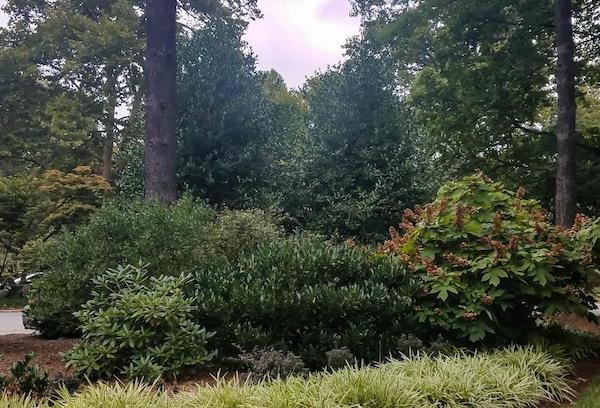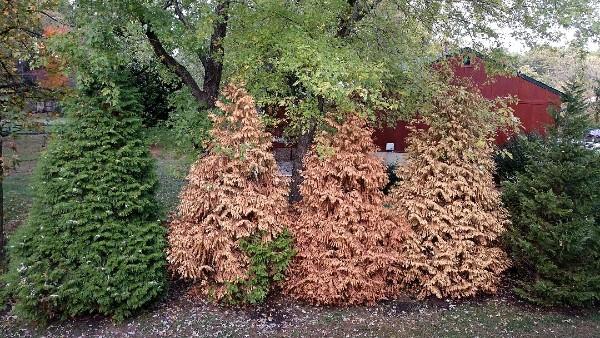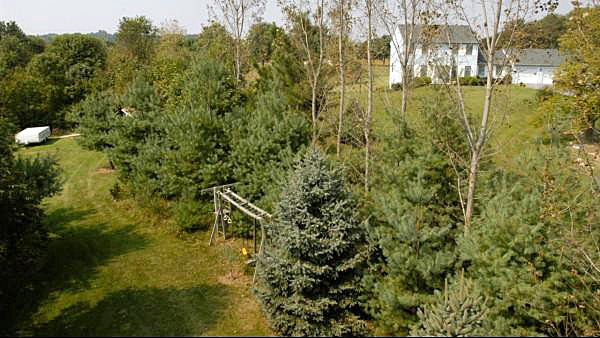The Corner that Caught My Eye: A Lesson in Mixed Screening
by Janet Scheren, Fairfax Master Gardener

Mixed evergreen screen
There’s a corner lot in our neighborhood that caught my eye from the day we moved here more than three decades ago. It’s a spot where you want to linger when walking your dog, drawn by the interplay of colors, textures and patterns among the leaves and tree forms. The seasonal changes only add to its charm. This beautiful corner also provides a great deal of privacy for our neighbors, whom I’ve gotten to know well over the years. We often chat near their mailbox, surrounded by the lovely screening of trees and shrubs.
Beyond beauty, mixed screening with shrubs and trees is one of the most effective ways to create privacy, block unwanted views, reduce noise and protect homes from wind. A mixed screen combines both deciduous and evergreen plants to create a layered, natural look that’s as functional as it is visually appealing. Evergreens provide the backbone with year-round coverage, but adding deciduous plants enriches the texture and seasonal interest. Plus, a diverse mix of plants helps guard against the disease and pest issues that monocultures often face.
Mix It Up To Avoid Monocultures
There are many reasons beyond aesthetics to avoid the monoculture border.

Easy spread of disease in monoculture
Increased Risk of Disease and Infestation: Monocultures — whether crops, annual flower beds, foundation plantings or screening borders — are highly vulnerable to pests and diseases that target specific species. If all the plants grouped together are the same or from the same family, a disease outbreak or pest infestation can easily spread through the entire planting, causing widespread damage or even complete loss. For example, Leyland cypress (Cuprocyparis leylandii), a highly popular screening tree, for example, is susceptible to such diseases as canker and root rot, as well as infestations of bagworms.
Replacement Woes: If one tree in a group of matched trees succumbs to disease or other factors, replacing it with a tree of the same species and size is challenging. A newly planted tree in a group will likely look out of place and may take years to match the size and appearance of those around it. Additionally, replanting the same species in the same location risks the new tree falling prey to the same problems.
Environmental Stress: Monocultures are often less resilient to environmental changes. A single species may thrive under current conditions but struggle with shifts in weather patterns or if the soil becomes less suitable over time. A mixed planting with various species is more likely to include plants that can adapt to changing conditions, ensuring the screen remains healthy and functional.
The Aesthetics and Practicality of Mixed Screens
In addition to reducing the risks of disease and pest infestation, mixed screens are visually appealing and provide numerous practical benefits.

Mixed pine evergreen screen
Diverse Visual Interest: Mixed screen borders bring variety to the landscape. By combining different species of trees and shrubs, homeowners and landscapers can create a visually dynamic border that offers year-round interest. Evergreen trees such as southern magnolia (Magnolia grandiflora) with its glossy leaves and white flowers can be paired with holly, boxwood, juniper or other conifers, for example, to provide a combination of textures and shades of green. The contrasting foliage, shapes, and colors of different plants add depth and richness to the landscape, making it more visually engaging.
Seasonal Changes: While evergreen plants provide constant coverage, adding deciduous plants to a mixed screen introduces seasonal changes in the landscape. Deciduous trees and shrubs bring vibrant fall colors, spring flowers and interesting branching patterns in winter, contributing to the year-round appeal of the screen.
Layered Structure: A well-designed mixed screen often includes layers of plants at different heights. Tall evergreen trees like eastern redcedar can be planted at the back of the screen to create vertical structure, while mid-sized shrubs such as Japanese holly or camellia provide mid-level coverage. Low-growing shrubs like boxwood can be used in the front to create a tiered effect. This layered approach not only enhances the screen’s appearance but also improves its functionality, as the varying heights and densities of plants can better block views and wind.
Wildlife Habitat: A diverse planting of evergreens and other species creates a more attractive habitat for wildlife. Birds and small animals are drawn to the variety of shelter and food sources that a mixed screen provides. For instance, the berries of American holly attract birds, while the dense foliage of yew and wax myrtle offers safe nesting sites.
Evergreen Trees and Shrubs for Mixed Screens
When planning a mixed screen, choosing a good selection of evergreen trees and shrubs is essential. Here are some popular options that work well in mixed screens, offering both aesthetic appeal and functional benefits.
Evergreen Trees
Green Giant Arborvitae
Green Giant Arborvitae is a fast-growing evergreen that provides quick privacy. Reaching up to 50 feet tall and 12 feet wide, its dense foliage effectively blocks views and wind, offering excellent windbreaks, noise reduction and visual barriers for enhanced landscape privacy.
Eastern Redcedar
Eastern redcedar is a hardy, drought-tolerant evergreen that reaches up to 40 feet in height. Its dense, columnar shape makes it ideal for windbreaks and privacy screens. This species is resistant to many pests and diseases, making it a reliable choice for mixed screens.
Southern Magnolia
Southern magnolia is a large evergreen tree known for its striking foliage and fragrant white flowers. Growing up to 80 feet tall, it adds both beauty and privacy to a mixed screen. Its broad, glossy leaves provide excellent coverage throughout the year.
Evergreen Shrubs
Boxwood
Boxwood is a classic evergreen shrub that offers low to mid-level coverage in mixed screens. It is commonly used in both formal and informal designs due to its dense foliage and ability to be pruned into various shapes.
Japanese Holly
Japanese holly is a versatile shrub with small, dark green leaves. It grows up to 10 feet tall and works well in both formal and informal mixed screens. Its compact growth habit makes it suitable for low to mid-level coverage.
Wax Myrtle
Wax myrtle is a fast-growing shrub that thrives in poor soils and coastal conditions. It can grow up to 20 feet tall and is ideal for use in southern landscapes, where it provides excellent wind protection and privacy.
For an expanded list of plants to include in your border, visit the resources listed below. These lists provide information about height, growth rate and soil and sun conditions needed for each.
Tips for Designing a Mixed Screen
When designing a mixed screen, it’s important to select plants that complement each other in size, growth rate and environmental requirements.
Avoid planting large numbers of the same species in one area. Instead, mix species with different growth habits, heights, and textures to create a more resilient and visually appealing screen. Additionally, planting an odd number of each species — one, three, five — creates movement and dynamic balance in your design.
Keep the mature size of each plant in mind. Some trees, like Green Giant Arborvitae, grow quickly and require space to spread, while others, like American holly, have a slower growth rate but provide long-term structure.
Choose plants that suit your maintenance preferences. Fast-growing species may require more frequent pruning to maintain their shape, while slower-growing species need less upkeep.
Mixed screening with evergreen trees and shrubs is not only about creating privacy but also about designing a resilient, aesthetically pleasing landscape. By incorporating a variety of species, you can avoid the pitfalls of monoculture, reduce the risks of disease and infestation and create a screen that is both functional and beautiful. The diversity of evergreen species ensures year-round coverage, while deciduous plants add seasonal interest, making the landscape dynamic and engaging throughout the year.
References
- Mixed Screens, Clemson Cooperative Extension
- Using Trees and Shrubs for Privacy and Wind Screening, Penn State Extension
- Evergreen Shrubs for Blocking Views, North Carolina State University Cooperative Extension, Henderson County
- Evergreen Trees for Screens and Hedges in the Landscape, University of Tennessee Agricultural Extension Service